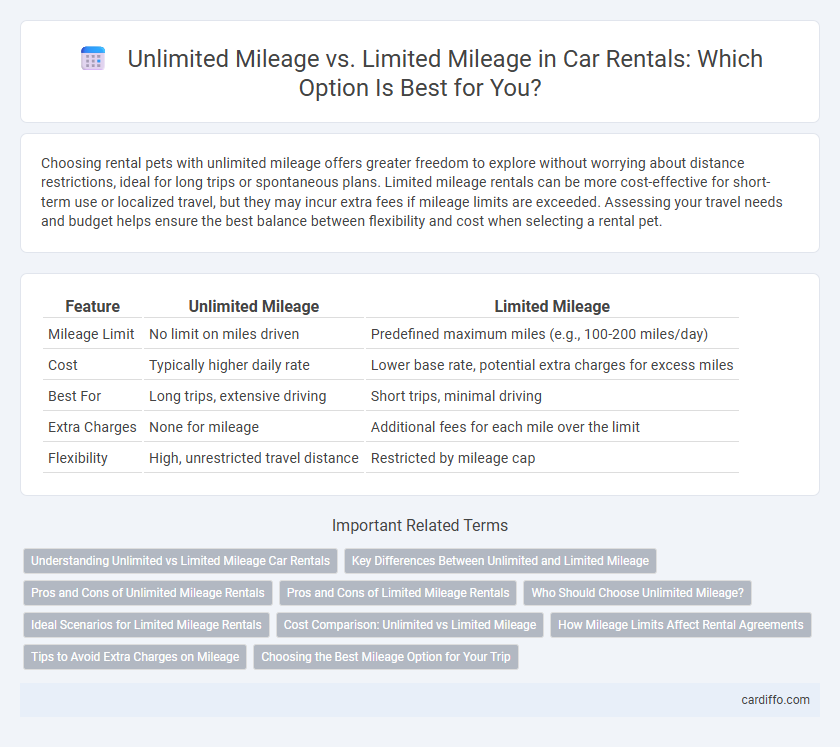Choosing rental pets with unlimited mileage offers greater freedom to explore without worrying about distance restrictions, ideal for long trips or spontaneous plans. Limited mileage rentals can be more cost-effective for short-term use or localized travel, but they may incur extra fees if mileage limits are exceeded. Assessing your travel needs and budget helps ensure the best balance between flexibility and cost when selecting a rental pet.
Table of Comparison
| Feature | Unlimited Mileage | Limited Mileage |
|---|---|---|
| Mileage Limit | No limit on miles driven | Predefined maximum miles (e.g., 100-200 miles/day) |
| Cost | Typically higher daily rate | Lower base rate, potential extra charges for excess miles |
| Best For | Long trips, extensive driving | Short trips, minimal driving |
| Extra Charges | None for mileage | Additional fees for each mile over the limit |
| Flexibility | High, unrestricted travel distance | Restricted by mileage cap |
Understanding Unlimited vs Limited Mileage Car Rentals
Unlimited mileage car rentals offer the freedom to drive without worrying about extra fees, making them ideal for long trips or spontaneous travel plans. Limited mileage rentals include a set number of miles, often ranging from 100 to 200 miles per day, with additional charges applied if the limit is exceeded. Choosing between unlimited and limited mileage depends on trip length and budget, as unlimited mileage can prevent unexpected costs, whereas limited mileage usually comes with a lower daily rate.
Key Differences Between Unlimited and Limited Mileage
Unlimited mileage rental allows customers to drive without restrictions on distance, providing greater flexibility for long trips and avoiding extra fees. Limited mileage rental imposes a fixed distance cap, often ranging from 100 to 200 miles per day, with additional charges applied for exceeding the limit. Choosing between unlimited and limited mileage depends on travel plans, where unlimited benefits long-distance travel and limited is cost-effective for shorter trips.
Pros and Cons of Unlimited Mileage Rentals
Unlimited mileage rentals offer the freedom to travel long distances without worrying about extra fees, ideal for road trips or extended stays. They provide cost predictability and convenience by eliminating the stress of monitoring mileage limits. However, these rentals often come at a higher daily rate, potentially increasing the overall rental cost compared to limited mileage options.
Pros and Cons of Limited Mileage Rentals
Limited mileage rentals offer cost-effective options by capping the number of miles driven, which helps control rental prices for short trips or city travel. Restrictions on mileage can lead to excess fees if the daily limit is exceeded, creating potential extra costs for renters. These rentals are ideal for budget-conscious customers who plan to drive within specified distances and prefer predictable expenses.
Who Should Choose Unlimited Mileage?
Travelers planning long-distance trips or extensive road adventures should choose unlimited mileage rental plans to avoid extra fees and maximize flexibility. Businesses requiring frequent vehicle use benefit from unlimited mileage by reducing cost uncertainties and improving budget control. Unlimited mileage options suit renters prioritizing freedom over distance without worrying about hidden charges.
Ideal Scenarios for Limited Mileage Rentals
Limited mileage rentals are ideal for short trips, daily commutes, and city driving where predictable distances stay within the mileage cap, helping renters avoid extra fees. Business travelers on fixed schedules or tourists exploring a single urban area benefit from cost-effective limited mileage options. This rental type suits customers looking to control expenses while staying within specific geographic boundaries.
Cost Comparison: Unlimited vs Limited Mileage
Unlimited mileage rental typically incurs higher daily rates but eliminates extra charges for long distances, making it cost-effective for extensive travel. Limited mileage rentals have lower base prices but impose fees per mile over the limit, potentially increasing overall costs for high-mileage users. Choosing between unlimited and limited mileage depends on anticipated travel distance, with unlimited plans favoring customers planning to cover more miles to avoid additional fees.
How Mileage Limits Affect Rental Agreements
Mileage limits in rental agreements directly impact overall costs and usage flexibility, often with unlimited mileage options priced higher for unrestricted travel. Limited mileage rentals impose daily or total distance caps, with excess miles incurring additional fees that increase total rental expenses. Understanding these terms helps renters balance budget constraints against travel needs, ensuring the chosen rental aligns with trip duration and destination plans.
Tips to Avoid Extra Charges on Mileage
Choosing a rental car with unlimited mileage eliminates the risk of costly overage fees, allowing drivers to travel freely without tracking every mile driven. When opting for limited mileage rentals, carefully estimate your trip distance and monitor the odometer to avoid surpassing the agreed limit, which often results in expensive charges per mile. Booking in advance and clarifying mileage policies with the rental company can further protect you from unexpected fees and maximize the value of your rental agreement.
Choosing the Best Mileage Option for Your Trip
Choosing between unlimited mileage and limited mileage rental options depends on your trip length and driving plans. Unlimited mileage offers freedom for long-distance travel or multiple stops without extra fees, while limited mileage is cost-effective for short trips with predictable routes. Evaluating your itinerary and potential driving distance ensures the best value and convenience for your rental experience.
Unlimited mileage vs Limited mileage Infographic

 cardiffo.com
cardiffo.com